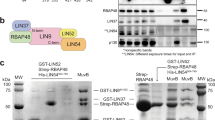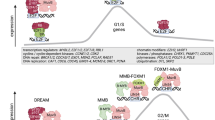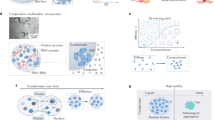Abstract
The PML gene encodes a tumour suppressor protein associated with a distinct subnuclear domain, the nuclear body. Various functions have been attributed to the PML nuclear body, but its main biochemical role is still unclear. Recent findings indicate that PML is essential for the proper formation of the nuclear body and can act as a transcriptional co-factor. Here we summarize the current understanding of the biological functions of PML and the nuclear body, and discuss a role for these intra-nuclear structures in the regulation of transcription.
This is a preview of subscription content, access via your institution
Access options
Subscribe to this journal
Receive 12 print issues and online access
$209.00 per year
only $17.42 per issue
Buy this article
- Purchase on Springer Link
- Instant access to full article PDF
Prices may be subject to local taxes which are calculated during checkout



Similar content being viewed by others
References
Pandolfi, P. P. et al. Structure and origin of the acute promyelocytic leukaemia myl/RARalpha cDNA and characterization of its retinoid-binding and transactivation properties. Oncogene 6, 1285– 1292 (1991).
de Thé, H. et al. The PML/RARalpha fusion mRNA generated by the t(15;17) translocation in acute promyelocytic leukaemia encodes a functionally altered RAR. Cell 66, 675–684 (1991).
Goddard, A. D., Borrow, P. S., Freemont, P. S. & Solomon, E. Characterization of a zinc finger gene disrupted by the t(15;17) in acute promyelocytic leukaemia. Science 254, 1371 –1374 (1991).
Kakizuka, A. et al. Chromosomal translocation t(15;17) in human acute promyelocytic leukaemia fuses RARalpha with a novel putative transcription factor, PML. Cell 66, 663–674 (1991).
Melnick, A. & Licht, J. D. Deconstructing a disease: RARalpha, its fusion partners, and their roles in the pathogenesis of acute promyelocytic leukaemia. Blood 93, 3167– 3215 (1999).
He, L. Z., Merghoub, T. & Pandolfi, P. P. In vivo analysis of the molecular pathogenesis of acute promyelocytic leukaemia in the mouse and its therapeutic implications . Oncogene 18, 5278–5292 (1999).
Sternsdorf, T., Grotzinger, T., Jensen, K. & Will, H. Nuclear dots: actors on many stages. Immunobiology 198, 307–331 (1997).
Bouteille, M., Laval, M. & Dupuy-Coin, A. M. in The Cell Nucleus (ed. Busch, H)5–64 (Academic Press, New York, 1974).
Ascoli, C. A. & Maul, G. G. Identification of a novel nuclear domain. J. Cell. Biol. 112, 785– 765 (1991).
Dyck, J. et al. A novel macromolecular structure is a target of the promyelocyte-retinoic acid receptor oncoprotein. Cell 76, 333– 343 (1994).
Koken, M. H. M. et al. The t(15;17) translocation alters a nuclear body in a retinoic acid-reversible fashion. EMBO J. 13, 1073 –1083 (1994).
Weis, K. et al. Retinoic acid regulates aberrant nuclear localization of PML-RARalpha in acute promyelocytic leukemic cells. Cell 76, 345–356 (1994).
Hodges, M., Tissot, C., Howe, K., Grimwade, D. & Freemont, P. S. Structure, organization, and dynamics of promyelocytic leukaemia protein nuclear bodies. Am. J. Hum. Genet. 63, 297–304 (1998).
Maul, G. G. Nuclear domain 10, the site of DNA virus transcription and replication. Bioessays 20, 660–667 (1998).
Scheer, U. & Weisenberger, D. The nucleolus. Curr. Opin. Cell Biol. 6, 354–359 (1994).
Koken, M. H. et al. The PML growth-suppressor has an altered expression in human oncogenesis. Oncogene 10, 1315– 1324 (1995).
LaMorte, V. J., Dyck, J. A., Ochs, R. L. & Evans, R. M. Localization of nascent RNA and CREB binding protein with the PML-containing nuclear body . Proc. Natl Acad. Sci. USA 95, 4991– 4996 (1998).
Alcalay, M. et al. The promyelocytic leukaemia gene product (PML) forms stable complexes with the retinoblastoma protein. Mol. Cell. Biol. 18, 1084–1093 (1998).
Zhong, S. et al. A role for PML and the nuclear body in genomic stability. Oncogene 18, 7941–7947 (1999).
Zhong, S. et al. PML and Daxx participate in a novel nuclear pathway for apoptosis . J. Exp. Med. 191, 631– 640 (2000).
Zhang, Y. & Xiong, Y. Mutations in human ARF exon 2 disrupt its nucleolar localization and impairs its ability to block nuclear export of MDM 2 and p53. Mol. Cell 3, 579– 591 (1999).
Ishov, A. M. et al. PML is critical for ND10 formation and recruits the PML-interacting protein daxx to this nuclear structure when modified by SUMO-1. J. Cell Biol. 147, 221–234 (1999).
Zhong, S., Muller, S., Freemont, P. S., Dejean, A. & Pandolfi, P. P. Role of SUMO-1 modified PML in nuclear body formation. Blood (in the press).
Boddy, M. N., Howe, K., Etkin, L. D., Solomon, E. & Freemont, P. S. PIC1, a novel ubiquitin-like protein which interacts with the PML component of a multiprotein complex that is disrupted in acute promyelocytic leukaemia. Oncogene 13, 971 –982 (1996).
Müller, S., Matunis, M. J. & Dejean, A. Conjugation with the ubiquitin-related modifier SUMO-1 regulates the partitioning of PML within the nucleus. EMBO J. 17, 61–70 (1998).
Kamitani, T. et al. Identification of three major sentrinization sites in PML . J. Biol. Chem. 273, 26675– 26682 (1998).
Matunis, M. J., Wu, J. & Blobel, G. SUMO-1 modification and its role in targeting the Ran GTPase-activating protein, RanGAP1, to the nuclear pore complex. J. Cell Biol. 140, 499–509 (1998).
Saitoh, H. & Hinchey, J. Functional heterogeneity of small ubiquitin-related protein modifiers SUMO-1 versus SUMO-2/3. J. Biol. Chem. 275, 6252–6258 (2000).
Sternsdorf, T., Jensen, K. & Will, H. Evidence for covalent modification of the nuclear dot-associated proteins PML and Sp100 by PIC1/SUMO-1. J. Cell Biol. 139, 1621–1634 (1997).
Sternsdorf, T., Jensen, K., Reich, B. & Will, H. The nuclear dot protein Sp100, characterization of domains necessary for dimerization, subcellular localization, and modification by small ubiquitin-like modifiers. J. Biol. Chem. 274, 12555–12566 (1999).
Li, S. J. & Hochstrasser, M. A new protease required for cell-cycle progression in yeast. Nature 398, 246–251 (1999).
Gong, L., Millas, S., Maul, G. G. & Yeh, E. T. Differential regulation of sentrinized proteins by a novel sentrin-specific protease. J. Biol. Chem. 275, 3355–3359 (2000).
Freemont, P. S., Hanson, I. M. & Trowsdale, J. A novel cysteine-rich sequence motif. Cell 64, 483–484 (1991).
Borden, K. L. B. & Freemont, P. S. The RING finger domain: a recent example of a sequence-structure family. Curr. Opin. Struct. Biol. 6, 395–401 (1996).
Kastner, P. et al. Structure, localization and transcriptional properties of two classes of retinoic acid receptor alpha fusion proteins in acute promyelocytic leukaemia (APL): structural similarities with a new family of oncoproteins . EMBO J. 11, 629–642 (1992).
Perez, A. et al. PML/RAR homodimers: distinct DNA binding properties and heteromeric interactions with RAR. EMBO J. 12, 3171– 3182 (1993).
Borden, K. L. B. et al. The solution structure of the RING finger domain from the acute promyelocytic leukaemia proto-oncoprotein PML. EMBO J. 14, 1532–1541 (1995).
Lavau, C. et al. The acute promyelocytic leukaemia-associated PML gene is induced by interferon. Oncogene 11, 871– 876 (1995).
Gaboli, M., Gandini, D., Delva, L., Wang, Z. G. & Pandolfi, P. P. Acute promyelocytic leukaemia as a model for cross-talk between interferon and retinoic acid pathways: from molecular biology to clinical applications. Leuk. Lymph. 30, 11– 22 (1998).
Ishov, A. M. & Maul, G. G. The periphery of nuclear domain 10 (ND10) as site of DNA virus deposition. J. Cell Biol. 134, 815–826 (1996).
Everett, R. G., Meredith, M. & Orr, A. The ability of herpes simplex virus type 1 immediate-early protein Vmw110 to bind to a ubiquitin-specific protease contributes to its roles in the activation of gene expression and stimulation of virus replication . J. Virol. 73, 417–426 (1999).
Mueller, S. & Dejean, A. Viral immediate-early proteins abrogate the modification by SUMO-1 of PML and Sp100 proteins, correlating with nuclear body disruption. J. Virol. 73,(1999).
Chelbi-Alix, M. K., Quignon, F., Pelicano, L., Koken, M. H. M. & de The, H. Resistance to virus infection conferred by the interferon-induced promyelocytic leukaemia protein. J. Virol. 72, 1043–1051 (1998).
Everett, R. D., Orr, A. & Preston, C. M. A viral activator of gene expression functions via the ubiquitin-proteasome pathway. EMBO J. 17, 7161–7169 (1998).
Ahn, J. H. & Hayward, G. S. The major immediate-early proteins IE1 and IE2 of human cytomegalovirus colocalize with and disrupt PML-associated nuclear bodies at very early times in infected permissive cells. J. Virol. 71, 4599–4613 (1997).
Szekely, L. et al. The Epstein-Barr virus-encoded nuclear antigen EBNA-5 accumulates in PML-containing bodies. J. Virol. 70, 2562–2568 (1996).
Swindle, C. S. et al. Human papillomavirus DNA replication compartments in a transient DNA replication system. J. Virol. 73, 1001 –1009 (1999).
Stadler, M. et al. Transcriptional induction of the PML growth suppressor gene by interferons is mediated through an ISRE and GAS element. Oncogene 11, 2565–2573 (1995).
Guldner, H. H., Szostecki, C., Grotzinger, T. & Will, H. IFN enhance expression of Sp100, an autoantigen in primary biliary cirrhosis . J. Immunol. 149, 4067– 4073 (1992).
Gongora, C. et al. Molecular cloning of a new interferon-induced PML nuclear body-associated protein. J. Biol. Chem. 272, 19457–19463 (1997).
Terris, B. et al. PML nuclear bodies are general targets for inflammation and cell proliferation. Cancer. Res. 55, 1590 –1597 (1995).
Wang, Z. G. et al. Role of PML in cell growth and the retinoic acid pathway. Science 279, 1547–1551 (1998).
Zheng, P. et al. Proto-oncogene PML controls genes devoted to MHC class I antigen presentation. Nature 396, 373– 376 (1998).
Larghero, J., Zassadowski, F., Rousselot, P. & Padua, R. A. Alteration of the PML proto-oncogene in leukemic cells does not abrogate expression of MHC class I antigens. Leukaemia 13, 1295 –1296 (1999).
Wang, Z.-G. et al. Pml is essential for multiple apoptotic pathways. Nature Genet. 20, 266–271 (1998).
Borden, K. L., Campbell Dwyer, E. J. & Salvato, M. S. The promyelocytic leukaemia protein PML has a pro-apoptotic activity mediated through its RING domain. FEBS Lett. 418, 30–34 (1997).
Quignon, F. et al. PML induces a novel caspase-independent death process. Nature Genet. 20, 259–265 (1998).
Fagioli, M. et al. Cooperation between the RING + B1-B2 and coiled-coil domains of PML is necessary for its effects on cell survival. Oncogene 16, 2905–2913 (1998).
Torii, S., Egan, D. A., Evans, R. A. & Reed, J. C. Human Daxx regulates Fas-induced apoptosis from nuclear PML oncogenic domains (PODs). EMBO J. 18, 6037– 6049 (1999).
Li, H. et al. Sequestration and inhibition of daxx-mediated transcriptional repression by PML. Mol. Cell. Biol. 20, 1784– 1796 (2000).
Mu, Z. M., Chin, K. V., Liu, J. H., Lozano, G. & Chang, K. S. PML, a growth suppressor disrupted in acute promyelocytic leukaemia. Mol. Cell. Biol. 14, 6858– 6867 (1994).
Le, X. F., Yang, P. & Chang, K. S. Analysis of the growth and transformation suppressor domain of promyelocytic leukaemia gene, PML. J. Biol. Chem. 271, 130–135 (1996).
Ellis, N. A. et al. The Bloom’s syndrome gene product is homologous to RecQ helicases. Cell 83, 655– 666 (1995).
Ellis, N. A. & German, J. Molecular genetics of Bloom’s syndrome. Hum. Mol. Genet. 5, 1457– 1463 (1996).
Miki, Y. et al. A strong candidate for the breast and ovarian cancer susceptibility gene BRCA1. Science 266, 66– 71 (1994).
Welsch, P. L., Owens, K. N. & King, M. C. Insights into the functions of BRCA1 and BRCA 2. Trends Genet. 16, 69–74 (2000).
Ahn, J. H., Brignole, E. J. r. & Hayward, G. S. Disruption of PML subnuclear domains by the acidic IE1 protein of human cytomegalovirus is mediated through interaction with PML and may modulate a RING finger-dependent cryptic transactivator function of PML. Mol. Cell. Biol. 18, 4899– 4913 (1998).
Vallian, S. et al. Transcriptional repression by the promyelocytic leukaemia protein, PML. Exp. Cell. Res. 237, 371– 382 (1997).
Rachez, C. et al. Ligand-dependent transcription activation by nuclear receptors requires the DRIP complex. Nature 398, 824 –828 (1999).
Naar, A. M. et al. Composite co-activator ARC mediates chromatin-directed transcriptional activation. Nature 398, 828– 832 (1999).
Fondell, J. D., Ge, H. & Roeder, R. G. Ligand induction of a transcriptionally active thyroid hormone receptor co-activator complex. Proc. Natl Acad. Sci. USA 93, 8329–8333 (1996).
Zhong, S. et al. A retinoic acid-dependent tumour-growth suppressive transcription complex is the target of the PML-RARα and T 18 oncoproteins. Nat. Genet. 23, 287–295 (1999).
Doucas, V., Tini, M., Egan, D. A. & Evans, R. M. Modulation of CREB binding protein function by the promyelocytic (PML) oncoprotein suggests a role for nuclear bodies in hormone signaling. Proc. Natl Acad. Sci. USA 96, 2627–2632 (1999).
Guiochon-Mantel, A. et al. Effect of PML and PML-RAR on the transactivation properties and subcellular distribution of steroid hormone receptors. Mol. Endocrinol. 9, 1791–1803 (1995).
Vallian, S. et al. Modulation of Fos-mediated AP-1 transcription by the promyelocytic leukaemia protein. Oncogene 16, 2843– 2853 (1998).
Vallian, S., Chin, K. V. & Chang, K. S. The promyelocytic leukaemia protein interacts with Sp1 and inhibits its transactivation of the epidermal growth factor receptor promoter. Mol. Cell. Biol. 18, 7147– 7156 (1998).
Doucas, V. & Evans, R. M. Human T-cell leukaemia retrovirus-Tax protein is a repressor of nuclear receptor signaling. Proc. Natl Acad. Sci. USA 96, 2633–2638 (1999).
Jiang, W. Q., Szekely, L., Klein, G. & Ringertz, N. Intranuclear redistribution of SV 40T, p53, and PML in a conditionally SV 40T-immortalized cell line. Exp. Cell Res. 229, 289– 300 (1996).
Lain, S., Midgley, C., Sparks, A., Lane, E. B. & Lane, D. P. An inhibitor of nuclear export activates the p53 response and induces the localization of HDM 2 and p53 to U 1A–positive nuclear bodies associated with the PODs. Exp. Cell Res. 248 , 457–472 (1999).
Gostissa, M. et al. Activation of p53 by conjugation to the ubiquitin-like protein SUMO-1. EMBO J. 18, 6462– 6471 (1999).
Rodriguez, M. S. et al. SUMO-1 modification activates the transcriptional response of p53. EMBO J. 18, 6455– 6461 (1999).
Chakravati, D. et al. Role of CBP/P300 in nuclear receptor signalling. Nature 383, 99–103 (1996).
Bannister, A. J. & Kouzarides, T. The CBP co-activator is a histone acetyltransferase. Nature 384, 641–643 (1996).
Boyes, J., Byfield, P., Nakatani, Y. & Ogryzko, V. Regulation of activity of the transcription factor GATA-1 by acetylation. Nature 396(1998).
Blobel, G. A., Nakajima, T., Eckner, R., Montminy, M. & Orkin, S. H. CREB-binding protein cooperates with transcription factor GATA-1 and is required for erythroid differentiation. Proc. Natl Acad. Sci. USA 95, 2061–2066 (1998).
Zhang, W. & Bieker, J. J. Acetylation and modulation of erythroid Kruppel-like factor (EKLF) activity by interaction with histone acetyltransferases. Proc. Natl Acad. Sci. USA 95, 9855–9860 (1998).
Remboutsika, E. et al. The putative nuclear receptor mediator TIF1alpha is tightly associated with euchromatin. J. Cell Sci. 112, 1671–1683 (1999).
Johnson, F. B. & al., e. Association of the Bloom Syndrome protein with Topoisomerase IIIalpha in somatic and meiotic cells. Cancer Res. (in the press).
Lai, H.-K. & Borden, K. L. B. The promyelocytic leukaemia (PML) protein suppresses cyclin D 1 protein production by altering the nuclear cytoplasmic distribution of cyclin D 1 mRNA. Oncogene (in the press).
Asano, K., Merrick, W. C. & Hershey, J. W. The translation initiation factor eIF 3-p 48 subunit is encoded by int-6, a site of frequent integration by the mouse mammary tumour virus genome. J. Biol. Chem. 272, 23477– 23480 (1997).
Everett, R. D. et al. A novel ubiquitin-specific protease is dynamically associated with the PML nuclear domain and binds to a herpesvirus regulatory protein . EMBO J. 16, 1519–1530 (1997).
Seeler, J.S., Marchio, A., Sitterling, D., Transy, C. & Dejean, A. Interaction of Sp100 with HP 1 proteins: a link between the promyelocytic leukaemia-associated nuclear bodies and the chromatin compartment. Proc. Natl Acad. Sci. USA 95 , 7316–7321 (1998).
Bloch, D. B., de la Monte, S. M., Guigaouri, P., Filippov, A. & Bloch, K. D. Identification and characterization of a leukocyte-specific component of the nuclear body. J. Biol. Chem. 271, 29198–29204 (1996).
Boisvert, F. M., Hendzel, M. J. & Bazett-Jones, D. P. Promyelocytic leukemia (PML) nuclear bodies are protein structures that do not accumulate RNA. J. Cell Biol. 148, 283–292 (2000).
Lehming, N., Le Saux, A., Schuller, J. & Ptashne, M. Chromatin components as part of a putative transcriptional repressing complex . Proc. Natl Acad. Sci. USA 95, 7322– 7326 (1998).
Acknowledgements
We would like to thank all the past and present members of the laboratory of Molecular and Developmental Biology at Memorial Sloan–Kettering Cancer Center, working on PML and related subjects: Maria Barna, Mantu Bhaumik, Laurent Delva, Mirella Gaboli, Domenica Gandini, Marco Giorgio, Ailan Guo, Li-Zhen He, Sundeep Kalantry, Taha Merghoub, Daniela Peruzzi, Roberta Rivi, Simona Ronchetti, Davide Ruggero, Zhu-Gang Wang, Hui Zhang, as well as Letizia Longo in our Department. P.S. is recipient of a ‘doctorate fellowship’ by the Medical School of the University of Modena, Italy. P.P.P. is a Scholar of the Leukemia and Lymphoma Society of America (formerly known as Leukemia Society of America). Our work is supported, by the NCI, the De Witt Wallace Fund for Memorial Sloan–Kettering Cancer centre, and NIH Grants to P.P.P.
Author information
Authors and Affiliations
Corresponding author
Rights and permissions
About this article
Cite this article
Zhong, S., Salomoni, P. & Pandolfi, P. The transcriptional role of PML and the nuclear body. Nat Cell Biol 2, E85–E90 (2000). https://doi.org/10.1038/35010583
Issue Date:
DOI: https://doi.org/10.1038/35010583
This article is cited by
-
Involvement of redox signalling in tumour cell dormancy and metastasis
Cancer and Metastasis Reviews (2023)
-
Phase separation drives tumor pathogenesis and evolution: all roads lead to Rome
Oncogene (2022)
-
Rigidity enhances a magic-number effect in polymer phase separation
Nature Communications (2020)
-
PML: Regulation and multifaceted function beyond tumor suppression
Cell & Bioscience (2018)
-
Stress induced nuclear granules form in response to accumulation of misfolded proteins in Caenorhabditis elegans
BMC Cell Biology (2017)



